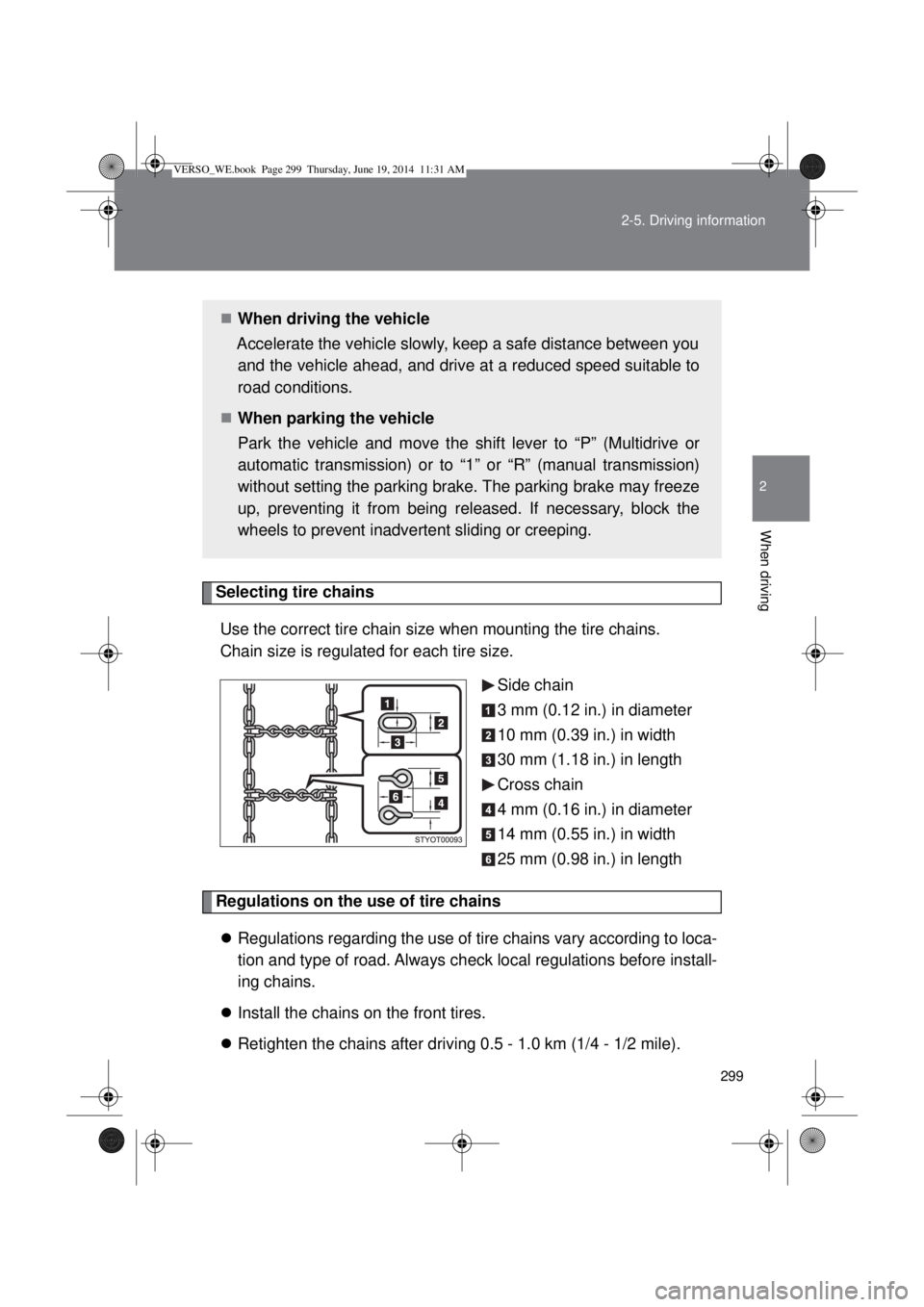2014 TOYOTA VERSO tires
[x] Cancel search: tiresPage 4 of 650

TABLE OF CONTENTSIndex
4
Sun visors ........................... 378
Vanity mirrors...................... 379
Conversation mirror ............ 380
Power outlets ...................... 381
Seat heaters...................... 383
Armrests............................ 385
Front seatback tables........ 386
Rear side sunshades........ 388
Assist grips ......................... 389
Floor mat............................. 390
Luggage compartment features .
392
4-1. Maintenance and care
Cleaning and protecting the ve-
hicle exterior ..................... 402
Cleaning and protecting the ve-
hicle interior ...................... 406
4-2. Maintenance
Maintenance requirements . 409
4-3. Do-it-yourself maintenance
Do-it-yourself service precau-
tions .................................. 412
Hood ................................... 416
Positioning a floor jack ........ 418
Engine compartment........... 420
Tires .................................... 443
Tire inflation pressure ......... 457
Wheels ................................ 459
Air conditioning filter ........... 462
Key battery.......................... 465Checking and replacing fuses ...
469
Light bulbs .......................... 484
5-1. Essential information
Emergency flashers ........... 502
If your vehicle needs to be towed
503
If you think something is wrong .
512
Fuel pump shut off system (gas-
oline engine)..................... 513
5-2. Steps to take in an emergency
If a warning light turns on or a
warning buzzer sounds... . 514
If a warning message is dis-
played............................... 523
If you have a flat tire (vehicles
with spare tire).................. 536
If you have a flat tire (vehicles
with emergency tire puncture
repair kit) .......................... 552
If the engine will not start ... 576
If the shift lever cannot be shifted
from “P” (vehicles with a Multid-
rive or an automatic transmis-
sion) ................................. 579
If you lose your keys .......... 580
If you cannot operate the back
door opener ...................... 581
If the electronic key does not op-
erate properly (vehicles with
smart entry & start system) .....
582
4Maintenance and care
5When trouble arises
VERSO_WE.book Page 4 Thursday, June 19, 2014 11:31 AM
Page 7 of 650

7
Tires
Rotation
Replacement
1
Temporary repair1
Inflation pressure
P. 443
P. 536
P. 552
P. 621
Rear window wiper P. 264
Side doors P. 73
Fuel filler door P. 118
Rear fog light (left-hand
drive vehicles)
P. 258
Rear fog light
(right-hand
drive vehicles)
P. 258
Rear window defoggerP. 326
License plate lights P. 251
Tail lights P. 251
Rear turn signal lights P. 224
Back doorP. 79
Rear view monitor
system camera
1*
*
: Refer to “Navigation and multimedia system Owner’s Manual”.1: If equipped
2: Vehicles with halogen headlights
3: Vehicles with discharge headlights
VERSO_WE.book Page 7 Thursday, June 19, 2014 11:31 AM
Page 184 of 650

184 2-1. Driving procedures
Starting on a steep uphill
Multidrive or automatic transmission
Firmly set the parking brake and shift the shift lever to “D” or
“M”.
Gently depress the accelerator pedal.
Release the parking brake.
Manual transmission
With the parking brake set and the clutch pedal fully
depressed, shift the shift lever to “1”.
Lightly depress the accelerator pedal at the same time as
gradually releasing the clutch pedal.
Release the parking brake. (P. 225)
Hill-Start Assist Control
The hill-start assist control allows you to smoothly start off the vehicle on a
steep or slippery uphill incline. (P. 293)
Driving in the rain
Drive carefully when it is raining, because visibility will be reduced, the
windows may become fogged-up, and the road will be slippery.
Drive carefully when it starts to rain, because the road surface will be
especially slippery.
Refrain from high speeds when driving on an expressway in the rain,
because there may be a layer of water between the tires and the road
surface, preventing the steering and brakes from operating properly.
VERSO_WE.book Page 184 Thursday, June 19, 2014 11:31 AM
Page 291 of 650

291 2-4. Using other driving systems
2
When driving
CAUTION
Any of the following conditions may result in an accident which could cause
death or serious injury:
The ABS does not operate effectively when
The limits of tire gripping performance have been exceeded (such as
excessively worn tires on a snow covered road).
The vehicle hydroplanes while driving at high speed on the wet or slick
road.
Stopping distance when the ABS is operating may exceed that of nor-
mal conditions
The ABS is not designed to shorten the vehicle’s stopping distance. Always
maintain a safe distance from the vehicle in front of you, especially in the fol-
lowing situations:
When driving on dirt, gravel or snow-covered roads
When driving with tire chains
When driving over bumps in the road
When driving over roads with potholes or uneven roads
TRC may not operate effectively when
Directional control and power may not be achievable while driving on slip-
pery road surfaces, even if the TRC is operating.
Do not drive the vehicle in conditions where stability and power may be lost.
When the VSC+ is activated
The slip indicator light flashes. Always drive carefully. Reckless driving may
cause an accident. Exercise particular care when the indicator light flashes.
When the TRC and VSC+ are off
Be especially careful and drive at a speed appropriate to the road condi-
tions. As these are systems to ensure vehicle stability and driving force, do
not turn off TRC and VSC+ unless necessary.
VERSO_WE.book Page 291 Thursday, June 19, 2014 11:31 AM
Page 292 of 650

292 2-4. Using other driving systems
CAUTION
Replacing tires
Make sure that all tires are of the same size, brand, tread pattern and total
load capacity. In addition, make sure that the tires are inflated to the speci-
fied tire pressure level.
The ABS and VSC+ systems will not function correctly if different tires are fit-
ted on the vehicle.
Contact any authorized Toyota dealer or repairer, or another duly qualified
and equipped professional for further information when replacing tires or
wheels.
Handling of tires and suspension
Using tires with any kind of problem or modifying the suspension will affect
the driving assist systems, and may cause the system to malfunction.
VERSO_WE.book Page 292 Thursday, June 19, 2014 11:31 AM
Page 298 of 650

298
2-5. Driving information
Winter driving tips
Carry out the necessary preparations and inspections before driving
the vehicle in winter. Always drive the vehicle in a manner appropri-
ate to the prevailing weather conditions.
Pre-winter preparations
Use fluids that are appropriate to the prevailing outside tem-
peratures.
• Engine oil
• Engine coolant
• Washer fluid
Have a service technician inspect the condition of the battery.
Have the vehicle fitted with four snow tires or purchase a set
of tire chains for the front tires.
Ensure that all tires are the same size and brand, and that chains
match the size of the tires.
Before driving the vehicle
Perform the following according to the driving conditions:
Do not try to forcibly open a window or move a wiper that is
frozen. Pour warm water over the frozen area to melt the ice.
Wipe away the water immediately to prevent it from freezing.
To ensure proper operation of the climate control system fan,
remove any snow that has accumulated on the air inlet vents
in front of the windshield.
Check for and remove any excess ice or snow that may have
accumulated on the exterior lights, vehicle’s roof, chassis,
around the tires or on the brakes.
Remove any snow or mud from the bottom of your shoes
before getting in the vehicle.
VERSO_WE.book Page 298 Thursday, June 19, 2014 11:31 AM
Page 299 of 650

299 2-5. Driving information
2
When driving
Selecting tire chains
Use the correct tire chain size when mounting the tire chains.
Chain size is regulated for each tire size.
Side chain
3 mm (0.12 in.) in diameter
10 mm (0.39 in.) in width
30 mm (1.18 in.) in length
Cross chain
4 mm (0.16 in.) in diameter
14 mm (0.55 in.) in width
25 mm (0.98 in.) in length
Regulations on the use of tire chains
Regulations regarding the use of tire chains vary according to loca-
tion and type of road. Always check local regulations before install-
ing chains.
Install the chains on the front tires.
Retighten the chains after driving 0.5 - 1.0 km (1/4 - 1/2 mile).
When driving the vehicle
Accelerate the vehicle slowly, keep a safe distance between you
and the vehicle ahead, and drive at a reduced speed suitable to
road conditions.
When parking the vehicle
Park the vehicle and move the shift lever to “P” (Multidrive or
automatic transmission) or to “1” or “R” (manual transmission)
without setting the parking brake. The parking brake may freeze
up, preventing it from being released. If necessary, block the
wheels to prevent inadvertent sliding or creeping.
VERSO_WE.book Page 299 Thursday, June 19, 2014 11:31 AM
Page 300 of 650

300 2-5. Driving information
Tire chain installation
Observe the following precautions when installing and removing chains:
Install and remove tire chains in a safe location.
Install tire chains on the front tires only. Do not install the chains on the
rear tires.
Install tire chains on front tires as tightly as possible. Retighten chains
after driving 0.5 1.0 km (1/4 1/2 mile).
Install tire chains following the instructions provided with the tire chains.
If wheel ornaments are used, they will be scratched by the chain band,
so remove the ornaments before putting on the chains.
CAUTION
Driving with snow tires
Observe the following precautions to reduce the risk of accidents.
Failing to do so may result in a loss of vehicle control and cause death or
serious injury.
Use tires of the size specified for your vehicle.
Maintain the recommended level of tire inflation pressure.
Do not drive at speeds in excess of the speed limit or the speed limit spec-
ified for the snow tires being used.
Snow tires should be installed on all wheels.
Driving with tire chains
Observe the following precautions to reduce the risk of accidents.
Failing to do so may result in the vehicle being unable to be driven safely,
and may cause death or serious injury.
Do not drive in excess of the speed limit specified for the tire chains being
used or 50 km/h (30 mph), whichever is lower.
Avoid driving on bumpy road surfaces or over potholes.
Avoid sudden acceleration, abrupt steering, sudden braking and shifting
operations that cause sudden engine braking.
Slow down sufficiently before entering a curve to ensure that vehicle con-
trol is maintained.
VERSO_WE.book Page 300 Thursday, June 19, 2014 11:31 AM